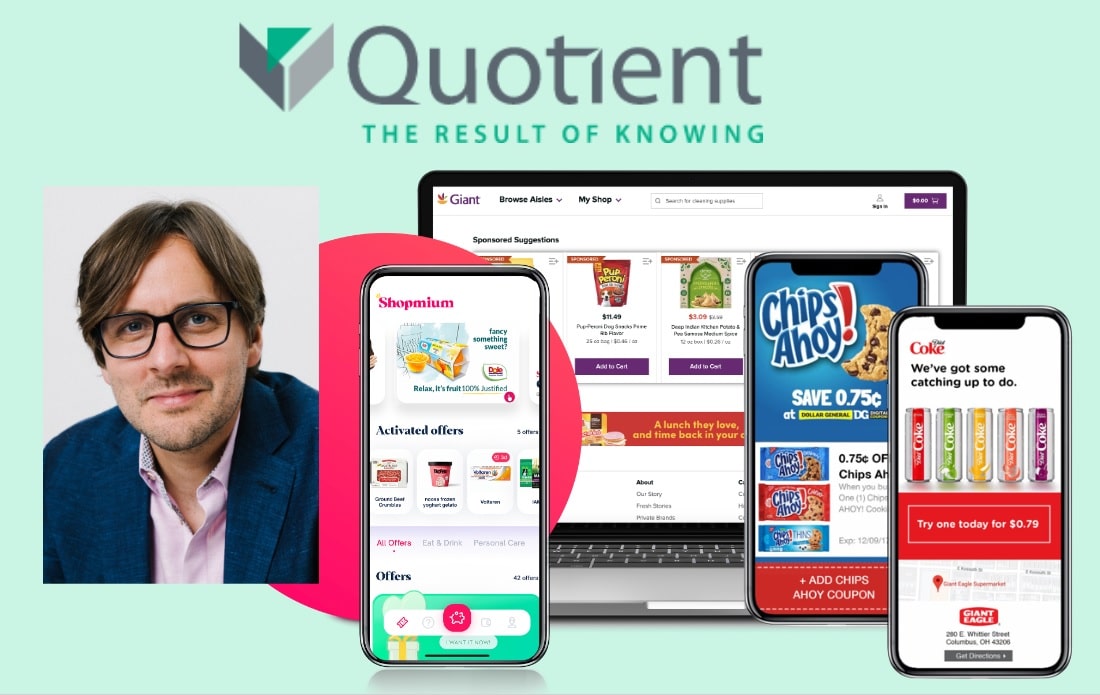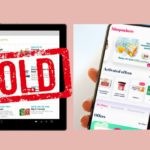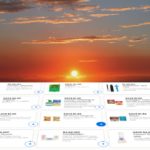
Many couponers breathed a sigh of relief last week, with the news that the internet’s leading print-at-home coupon site would live on under new ownership, while those who prefer cash-back offers now have another savings app to try.
The American relaunch of the European savings app Shopmium, and the sale of Coupons.com to the European company GSG, are among the many changes that have taken place, and are still to come, at Quotient Technology. Back in May, Matt Krepsik took over as only the second CEO in the company’s 24-year history, after founder Steven Boal stepped down. The new boss is now ushering the company into a new era – a “new golden age of promotions” as he sees it, where coupons and cash-back offers are only the beginning.
Krepsik spoke with Coupons in the News to talk about the changes that have taken place, and are yet to come. Our conversation follows, lightly edited for length and flow:
CITN: I want to talk about you, and your vision for the company as you bring it into a new era under new leadership. But why don’t we start by talking about the latest news, and about Shopmium. The process of evolving from coupons to cash back has been ongoing for a long time. So what are your thoughts about the changing promotional landscape that prompted this move, especially considering Quotient once retired Shopmium in favor of Coupons.com, and now it’s the other way around?
KREPSIK: As I look at the moment we’re in right now today with inflation, and I look at the challenges and pressures on consumers, how do we actually make sure we can deliver more offers, more promotions, across more touchpoints? Consumers want to save a multitude of different ways. We don’t really want to force a consumer to say, I only want to save with cash back, or I only want to earn rewards, or I only want to have dollars off the register. We want to make that a consumer choice, we don’t want it to be a Quotient choice.
So, as we looked at Shopmium and why we think it was a great opportunity to bring it across the pond to the U.S., it really supports discovery for brands. So as consumers, as you log into the app, it really is focused on helping find products, new products, interesting products that you as a consumer may want to add to your list. Now there’s a lot of features that we’re looking to add to the app here over the coming weeks, months and quarters. But as an application, or as a consumer touchpoint, we really focus that app on supporting that discovery and planning process for consumers and giving them the option now on how they want to save and how they want to earn rewards.
And people that use the app really love the app. We see them using it after discovery and planning, We see them using it even in store to check prices, to make sure I’m getting the best deal at the store. And so, we want to continue that tradition here in the U.S. And we’re really excited about that.
We’ll also continue to push our content offers out to other consumer touchpoints. So they might be using Amazon Alexa to build their shopping list, they might be using their retail loyalty app to build their shopping list and discover offers for promotion. So we really look at Shopmium as just a part of the network.
CITN: Let’s talk about some of those other formats that you have available. There were some concerns among print-at-home fans that the format would go away entirely once the shift to Shopmium occurred. But now, we see that Quotient will continue to provide print-at-home offers to populate the Coupons.com site. Is that arrangement expected to continue indefinitely, are there plans at some point for GSG to take over full responsibility for the site and its offers? What’s the long-term plan there?
KREPSIK: We look at GSG and that team there really as a strong partnership. Their specialization, especially in Europe, has been on the website side. We will continue to make those print-at-home offers available via GSG and their assets. We also make those offers available via Microsoft. So we’ll continue to make sure we’ll continue to have print-at-home as part of the portfolio, and we’ll really look through some of our partners to distribute that content, so that way that content will be available on the web page, and will be available for them in the various different shopping locations where it makes sense.
CITN: Your predecessor Steven Boal once said that paper coupons, including print-at-home, will “go the way of the dinosaur and the dodo bird” eventually. How can we read into Quotient continuing to provide these print-at-home offers via GSG – is that a vote of confidence in the future of the format, or more of a business arrangement for as long as GSG and your clients and consumers have some interest remaining in the format?
KREPSIK: I would say it’s more of the latter, in terms of, as long as consumers have interest, we see GSG as a good partner to continue to enable that format for consumers.
CITN: What’s the status of load-to-card coupons? Will any of those arrangements with retailers change, with Quotient powering their digital coupon platforms?
KREPSIK: We continue to make progress there with our load-to-card partners. So we’re actually in the process of renewing most of our major load-to-card partners, and actually continuing to look at expanding that overall network. So we really think load-to-card is an important part of the business, and I think really where I see it going next is actually what I would call more load-to-cart, so you see some of the experiences that we’re putting together in the e-commerce side, with Microsoft, we’re actually really pushing the envelope there in terms of how do you actually add offers directly to the checkout cart.
CITN: That brings up the question of where Quotient fits in, if at all, with the Universal Digital Coupon initiative. Some companies are fully on board at this point, others are more wait-and-see. Where does Quotient fit into that? Are you looking at getting involved?
KREPSIK: I would say, with the Universal Coupon, I think for the industry, it’s an important step forward, that has to be led from a consumer choice standpoint. So, I think as more consumers look for the ease of access to offers, and the ease of utilization of offers, I think that will be a natural progression towards 8112 [the new Universal Coupon application Identifier]. But I think it’s going to be consumers that lead us there. It’s why a cash-back app, or an app like a Shopmium, can be important and can be an important consumer vehicle for 8112. There will be some location-based capabilities we’re launching soon, and that’s a great way for consumers, if they’re looking for a Universal Coupon that they can utilize, they can see where that offer is available. So helping consumer choice drive that I think is where we as a company will really support that. But I think it’s, in my mind, getting closer to the checkout, getting closer to the transaction, and really making it easier and easier for consumers to redeem value.
CITN: When you talk about giving consumers a choice in how they want to redeem offers and discover offers, there was a lot of controversy several years ago about, what is a cash back offer exactly? Can it be combined with coupons, can it be combined with digital coupons, or are these separate, distinct things that can’t all be combined? Do you feel like that’s kind of settled down now? Is there still some consumer or client confusion, or are we in a place now where these things can all coexist peacefully without overlapping?
KREPSIK: I think we’re getting to a better position than we were in the past. I think what we see from brands is still, they want to make sure that consumers aren’t stacking. That’s probably the number-one question we get from our brand partners is, when we put these offers out there and we put out these different versions so we enable consumer choice, how do you make sure that consumers really aren’t stacking these offers, how do you make sure there’s no fraud in the system? So fraud prevention, anti-stacking is still a really important part of our dialogue, just given the size and scope and breadth of our network. So I think a lot of that, in my mind, has settled down, but it’s still an important part of the dialogue and conversation.
CITN: It’s a tough promotional environment right now, with companies dealing with supply chain and cost challenges, out-of-stocks, many of them have pulled back on promotions, coupon distribution and redemption numbers are still way down. What’s been your message to clients, to the CPG industry, to retailers, about the importance of promotions? What’s the value nowadays in running a coupon campaign or a cash back offer, versus, say, a temporary price reduction in store?
KREPSIK: It’s a really good question. I look at it as, it’s a more efficient vehicle. The value that digital promotions and rebates and offers provide is the ability to be addressable, the ability to be very tactical, to be very personalized, which is a more efficient vehicle for a brand in the marketplace. Instead of having a dollar-off, TPR [temporary price reduction], “stack-it-high and sell-it-low,” they can really deliver a good, addressable offer to a certain unique group of consumers that they want to keep in the category, where they want to keep their brand in the basket. And so, when we talk to brands and CPGs, in my mind, it’s almost like this inflection point, where I think we can usher in a new golden age of promotions, where promotions does become a true programmatic and addressable vehicle that allows us as an industry to evolve from the the days of broad-based TPRs.
And in terms of the data that we’re seeing in our network, despite the downward pressure on the overall TPR space and promotion space, we actually do continue to see more utilization of our content on our network than we ever have before. So we continue to see positive momentum in terms of the amount of savings we deliver. So despite the inflationary environment, despite brands pulling back, consumers are looking for value more.
CITN: So when we talk about personalization, about targeting consumers, is that where you see things heading in the next several years, away from these broad-based, available-to-everybody type of offers?
KREPSIK: I do see it moving towards more personalization. When I log into an app to go to the store, my daughter’s in college, my son’s in high school, so just because “baby” is the alphabetically-first category in the order doesn’t mean I should be seeing baby diaper offers at the top of the pick list. And so, as a consumer, I value apps that understand my choice and my preference, and things that help me become more efficient as a consumer. We all have tons of things that are vying for our attention. So the ability to realize that there’s a great offer out there for a brand that I love that I haven’t purchased in a while, or a product that I like that I haven’t purchased in a while, or something I might even be interested in, I think we’ve seen, as marketers, the value and the benefit from having more personalized content and the impact that can have on purchase. It goes back to the John Wanamaker problem, where “50% of my advertising doesn’t work, but I don’t know which 50%.” I think that holds true in the promotion space. Not every promotion campaign that a CPG or a manufacturer runs is going to be effective if you’re just spraying and praying and hoping everybody sees the offer. So really being more personalized, really being more bespoke for consumers and really making it addressable for brands, in my mind is an incredible opportunity for the category and the marketplace.
CITN: The near-term trajectory of Quotient under Steven Boal was pretty clear – an eventual shift away from paper and print-at-home type offers to digital and cash back. The news last week seems to be the fulfillment of all that. So now that you’re the boss, where do you see things headed next? Do you plan to continue following that course, or do you plan to steer things in a different direction – what kind of stamp do you expect to put on the company and the industry?
KREPSIK: Our biggest focus is moving more towards programmatic and addressable offers. I think that’s really where there’s the biggest opportunity. We’ve spent a lot of time since I’ve been here at Quotient focused on expanding our network beyond just load-to-card. So I think in the past year we’ve added a large group of partners to our network that are other consumer experiences, other consumer touchpoints that we don’t need to be the only app where consumers engage with promotion content and offers. We’re happy to distribute that out there, but we want to make that focused on performance and generating returns for brands and purchases for consumers of products they like. So we’ll continue to march down that path of personalization and that addressability of the industry and the landscape.
CITN: From a consumer perspective, a lot of people feel a bit unsettled, as offers are getting more personalized and more specific. When you think, back in the day, coupon blogs could say, go to your Sunday paper, cut out this coupon, use it at this store and you can save on this product, whereas now, everybody’s increasingly getting different offers. It’s not necessarily a bad thing if you’re getting personalized promotions that are relevant to you. But it’s very different from being able to print or cut out a coupon and use it in the store, knowing that everybody has the same offers available to them. So how can shoppers adapt to this new world?
KREPSIK: That’s really, in many ways as we think about our path forward, how do you still enable choice and discovery for consumers? So, the one nice thing with the FSI is, a consumer can look through it and spend time finding the right offer that made sense for them. I still think there’s an opportunity for discovery in the digital ecosystem, how consumers can choose to opt in to value and find the best content out there. And I think we still have more work to do to figure that out.
Images from: Quotient Technology
















You should have asked, “why didn’t you just rename your coupons.com app to Shopmium, rather than rolling out a new app which is missing much of the functionality of the current app that you’re going to kill?”